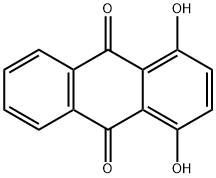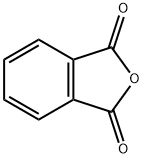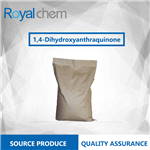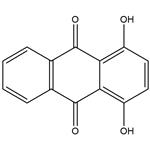Chemical Properties
orange to red-brown crystalline powder
Uses
1,4-Dihydroxyanthraquinone is used to color gasoline and some heating oils. It is used as an intermediate for the synthesis of indanthrene- and alizarin-derived dyes. It is also used to form lake pigments with calcium, barium and lead. It may be used in the synthesis of cyclopentanoids by cyclization of α,β-unsaturated aldehyde with 1,4-Dihydroxyanthraquinone. It has been studied as a long range emissive ratiometric fluorescent probe for live cell imaging.
Uses
1,4-Dihydroxyanthraquinone, also known as quinizarin, is of great importance in manufacturing disperse, acid, and vat dyes.
Uses
Antioxidant in synthetic lubricants, dyes.
Definition
ChEBI: Quinizarin is a dihydroxyanthraquinone having the two hydroxy substituents at the 1- and 4-positions; formally derived from anthraquinone by replacement of two hydrogen atoms by hydroxy groups It has a role as a dye.
Manufacturing Process
1,4-Dihydroxyanthraquinone is commonly known as Quinizarin.
(a) Boric acid, boric acid and mercury, boric acid and nitrous acid or nitrous acid and mercury in the presence of Anthracene-9,10-dione with sulfuric acid;
(b) In the presence of boric acid and nitrous acid, treated with sulfuric acid 1-Hydroxyanthracene-9,10-dione or 2-Hydroxyanthracene-9,10-dione,
(c)In the presence of boric acid, treated with sulfuric acid 1-Hydroxy-4-nitroanthracene-9,10-dione or 1,4-Dichloroanthracene-9,10-dione;
(d) in the Boric acid and where did in the presence of sulfuric acid, Phthalic anhydride and 4-Chlorophenol ;or Hydroquinone condensation, closed loop.
General Description
1,4-Dihydroxyanthraquinone is an organic dye molecule with an aromatic structure. It is a derivative of anthraquinone bearing hydroxyl moieties. They may find uses in pharmacological, biochemical and dye industries. Anthraquinone dye are resistant to degradation.
Flammability and Explosibility
Non flammable
Safety Profile
Poison by intravenous
route. Moderately toxic by intraperitoneal
route. Mutation data reported. An eye
irritant. A weak allergen. When heated todecomposition it emits acrid smoke and
irritating fumes.
Synthesis
At 250 DEG C, heat boric acid 10h, obtain boric acid dehydration compound; Recording boric anhydride in boric acid dehydration compound through ultimate analysis is 99.3%, tetraboric acid 0.7%;In condensation reaction still, add oleum 350kg, phthalic anhydride 120kg, boric acid dehydration compound 40kg, para-chlorophenol 100kg(oleum: phthalic anhydride: metaboric acid: para-chlorophenol=3.5:1.2:0.4:1); Oil bath is warmed up to material 100 DEG C, accurately controls temperature of reaction 100 ~ 105 DEG C, is incubated 0.5 hour; Binder is in the hydrolysis kettle being added with 300L water, and adjustment temperature to 50 DEG C, 50 DEG C of insulations 0.1 hour, discharging press filtration, is washed to neutrality, dries up and obtains 1,4-hydroxyanthraquinone tide product 400.2kg, detect water ratio 54.2%, give money as a gift product 183.3kg, passes through liquid-phase chromatographic analysis, 1, the content of 4-hydroxyanthraquinone reaches 98.74%, dry product purity 97.12%, and yield is 94.1%.
Purification Methods
Crystallise quinizarin from glacial acetic acid. [Beilstein 8 H 450, 8 IV 3260.]
Properties and Applications
orange. Orange red powder. Insoluble in water, soluble in ether, in strong base in certain solubility, but soluble in organic solvent oil, etc. In concentrated sulfuric acid in green yellow fluorescence. Mainly used for oil coloring. Also used in all kinds of plastic and resin, light industry products coloring.






